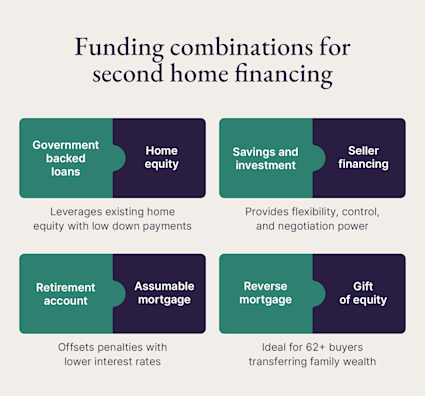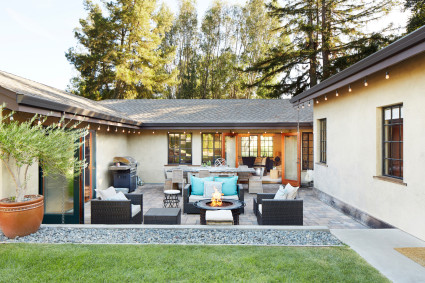1. Savings and investment account
Using your personal bank account to fund your second home down payment is about as straightforward as it gets. The money is easily accessible and will only earn minimal interest if left in the account. Putting these funds to work may be smarter rather than taking out a larger loan for a second home. You may also be eligible for a 401(k) loan under the age of 59. But that’s not the only personal fund you can tap into for financing a vacation home or second home.Using money from your investment account is similar to withdrawing from your savings account. The key difference is that you may need to pay taxes on any gains the money earned while invested.| Pros | Cons |
| No debt or interest payments involved | Depletes liquid assets that could be used for emergencies |
| Immediate availability without approval processes | May miss out on potential investment returns |
| Preserves your borrowing capacity for other needs | Could significantly impact your overall financial cushion |
2. Sale of an asset
Selling assets when you come up short on funds may be the only way to keep that second home of your dreams from slipping through your fingers. Understanding how much your down payment for a second home will be will help determine which assets might need to be liquidated.| Pros | Cons |
| Converts underutilized assets into real estate equity | May trigger capital gains taxes |
| Potentially eliminates the need for additional debt | Market timing concerns could lead to selling at a loss |
| Can simplify your portfolio by consolidating investments | Permanent loss of the asset and its future appreciation potential |
3. Retirement account
Tapping into retirement accounts, such as a 401(k) or IRA, can be a source of funds for your down payment for a second home. However, this age-sensitive strategy may not be advisable for those nearing retirement.| Pros | Cons |
| Access to potentially substantial funds | Early withdrawal penalties may apply (typically 10%) |
| First-time homebuyer exceptions may allow penalty-free withdrawals (for certain accounts) | Reduces the power of compound growth in retirement accounts |
| Could diversify retirement portfolio into real estate | May significantly impact long-term retirement planning |
4. Home equity loan or HELOC
The value you've built in your current home can be a powerful resource when purchasing a second property. Leveraging your home equity gives you access to funds at generally favorable rates compared to many other financing options.A practical approach to securing funds for a second home down payment is utilizing the equity you've accumulated in your primary residence. This strategy involves either securing a second home mortgage or expanding your current one, letting you convert your home's value into cash for that vacation property you've been eyeing.Home equity loan
With a home equity loan, you receive a one-time payment based on a portion of your home's value through a secondary mortgage. The key benefit is maintaining your original mortgage intact — particularly advantageous if you have a favorable interest rate. Since these loans are second in line for repayment if financial difficulties arise, they typically carry higher interest rates than current mortgage rates for second home loans.Home Equity Line of Credit (HELOC)
A HELOC functions as a secondary mortgage but operates more flexibly, similar to a revolving credit account. During the initial access period (generally five to 10 years), you can withdraw and replace funds repeatedly. You'll only pay interest on the amount currently borrowed. After this period ends, the withdrawal option closes, and you begin repaying both principal and interest on whatever balance remains. Since HELOCs feature adjustable rates, your payments may fluctuate monthly based on market conditions.Cash-Out Refinance
When choosing a cash-out refinance, you're replacing your current mortgage entirely with a new, larger loan and receiving the difference as funds for your second home. These typically come with better interest rates than secondary mortgages because they hold a priority position for repayment.| Pros | Cons |
| Typically offers considerably lower interest rates than unsecured financing options | Creates additional risk to your primary home if financial difficulties arise |
| Potential tax advantages on interest payments (check with your tax professional) | Decreases your ownership stake in your primary residence |
| Enables access to substantial funds while preserving other financial resources | Could significantly lengthen your overall mortgage repayment timeline |
5. Government-backed loans
While traditional government-backed loans are designed for primary residences, there are strategic ways to use these programs that can help you own multiple homes. This option may provide a pathway for those wondering how to buy a second home with no down payment.Government-backed loans such as VA or USDA offer low or no down payment options, typically for primary residences rather than second homes. However, by carefully planning your home purchases, you can transition from one primary residence to another while retaining your previous home as a second property.- VA loan: VA loans offer eligible service members, veterans and qualifying spouses the opportunity to purchase a home with no down payment. The strategy involves buying a new primary residence with your VA loan benefit, occupying it as required and then converting your former home into a second property once you've established residency in the new location.
- USDA loan: USDA loans provide no-down-payment options for properties in designated rural areas to buyers whose household income doesn't exceed 115% of the area median. Similar to the VA approach, you can purchase a qualifying home as your primary residence and later transition your former property into a second home after fulfilling all occupancy requirements.
| Pros | Cons |
| Minimal or zero down payment requirements | Occupancy requirements must be strictly followed |
| Typically lower interest rates than conventional loans | Limited to specific locations or borrower qualifications |
| Flexible credit requirements compared to traditional financing | This process can be lengthy and involve more paperwork |
6. Reverse mortgage
A reverse mortgage allows homeowners aged 62 and older to convert part of their home equity into cash without having to sell their home or pay additional monthly bills. The loan is repaid when the borrower moves out, sells the home or passes away, making it a potential source for second home down payment for retirees.| Pros | Cons |
| No monthly mortgage payments required on the primary home | Reduces inheritance for heirs |
| Funds can be used flexibly for any purpose, including a second home | Includes fees, closing costs and accruing interest |
| Doesn't affect Social Security or Medicare benefits | Requires maintaining the home, paying property taxes and keeping homeowner's insurance |
7. Gift of equity funds
When purchasing a second home from a family member, a gift of equity can be mutually beneficial. This approach involves the seller (often a parent or relative) transferring a portion of their equity in the property to you as a gift, effectively reducing the purchase price and minimum down payment for a second home.| Pros | Cons |
| Reduces or eliminates the need for cash down payment | Potential tax implications for the seller |
| Can help keep property within the family | May create complicated family dynamics |
| May allow for more favorable purchase terms than market rate | Requires proper documentation to satisfy mortgage lenders |
8. Assumable mortgages
An assumable mortgage allows you to take over the seller's existing loan instead of obtaining a new one. This can be particularly advantageous in a rising interest rate environment, as you may be able to secure a lower rate than what's currently available. This is an excellent option for those researching how to buy a second home with low down payment.| Pros | Cons |
| Potential to secure a below-market interest rate | May still require a down payment to cover the equity difference |
| Lower closing costs than a new mortgage | Limited availability |
| Simplified qualification process compared to new financing | Lender approval is required, and not all sellers have assumable loans |
9. Seller financing
Seller financing creates a direct financial arrangement between you and the property seller, bypassing traditional mortgage lenders. The seller essentially becomes your lender, allowing you to pay them directly according to mutually agreed terms. This option can be helpful when considering a loan for a second home with non-traditional terms.| Pros | Cons |
| Flexible terms that can be customized to both parties' needs | Often includes higher interest rates than conventional loans |
| Potentially faster closing process without traditional bank approvals | Sellers may require a substantial down payment |
| It may be accessible to buyers with credit challenges | Less regulatory protection than traditional mortgage lenders |
10. Lease with an option to buy
This arrangement allows you to rent a property while securing the right to purchase it in the future. During the lease period, a portion of your monthly rent may be credited toward the eventual down payment on a second home, helping you build equity while you live there.| Pros | Cons |
| Build equity through rent payments while deciding if the property is right for you | May pay a premium on rent for the purchase option |
| Lock in purchase price before potential market increases | Risk losing accumulated credits if you decide not to buy |
| Time to improve credit or save additional funds before purchasing | Limited control over the property until purchase is complete |

Are second home down payments always required?
In most cases, a down payment on a second home is required. If you plan to pursue a conventional loan for financing a second home, you’ll need to put money down upfront since they aren’t backed by the government. Even if you plan to pay for the home entirely in cash, you’re still technically putting down a large payment. If you plan to turn your second home into a primary residence, then it’s possible to get a government-backed loan. In that case, you won’t need a down payment for a second home.| Pro tip: Use a second home calculator to find out how much you can afford to spend on your vacation home. |
How much do I need for a down payment on a second home?
The down payment for a first home can be as low as 0% and as high as 20% for a conventional loan. However, the required down payment for a second home is around 10%, and sometimes more than 20%. The amount you’ll need for a down payment on a second home depends on several factors, including your credit score, your debt-to-income (DTI) ratio and the cost and type of property you’re purchasing. Down payments and interest rates for second homes can also vary depending on the lender, so it’s a good idea to shop around.Here is a closer look at how these factors can affect your down payment:- Credit score: The higher your credit score, the less money lenders will require for a down payment on a second home.
- Debt-to-income ratio: A lower DTI can often mean a lower down payment for your second home.
- Property type: A second home classified as an investment property will require a higher down payment than one classified as a vacation home.
- Cost of property: Financing a less expensive property is a lower risk for a lender, so it will require less money down.
- Lender variations: Lenders may have different criteria and risk assessments, leading to varied down payment requirements.
Any tips on how I can reduce the down payment on my second home?
One of the best ways to lower the out-of-pocket expense for a second home down payment is by reducing how much you’re paying for the home. But that doesn’t necessarily mean sacrificing square footage, quality or location. Pacaso’s LLC co-ownership model allows you to own one-eighth to one-half interest in a beautiful, spacious second home in a prime vacation destination, giving you full ownership rights without the full price tag. Pacaso also offers a variety of financing options to help you achieve your dream of second home ownership.Explore your options for second home ownership
Finding the right financing strategy can help you achieve your dream of owning a second home, whether through a government-backed loan, a conventional mortgage, or co-ownership. If you’re looking for a modern, hassle-free way to own a second home, Pacaso makes it possible.Pacaso offers LLC co-ownership of luxury second homes, providing a streamlined and cost-effective alternative to traditional second homeownership. With professionally managed properties and a fully integrated ownership model, you can enjoy all the benefits of a second home without the hassle of maintenance.Want to learn more? Visit our Learn page for expert insights on second home ownership, financing options, and more.FAQs about second home down payments
01: Do you have to put a 20% down payment on a second home?
A down payment of 20% isn’t always required for purchasing a second home. The lowest down payment you can expect to pay is 10%. Ultimately, the lender you use and your financial situation will determine the down payment you must have.
02: Can you write off a second home?
Second homes are eligible for tax deductions, but it will depend on how the house is used. Investment properties can deduct maintenance expenses, while deductions for personal vacation homes are much more limited.
03: Can a married couple have two primary residences?
A married couple can claim only one primary residence on their taxes. This is the home where they live for the greatest amount of time throughout the year.










